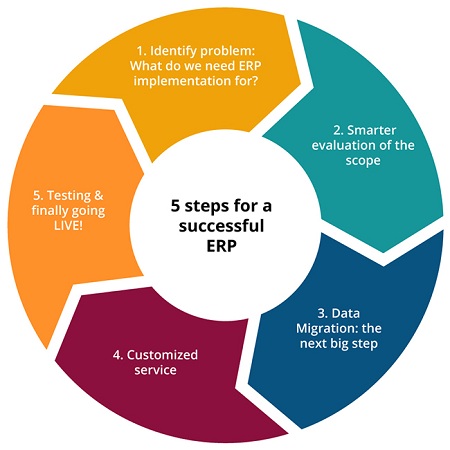Here are the 5 steps for a successful ERP implementation:
1. Identify the problem: Why do we need an ERP implementation?
You can easily streamline your business processes, collect and view data, and eliminate repetitive processes, with a cloud ERP digital transformation. Greater work efficiency has become more achievable with cloud ERP software reducing the traditional practice of manually keeping track of information. Your ERP system will provide security, data accuracy, efficient business operations, lower costs, and greater production levels.
2. Understanding of the scope of implementation
A leading Panorama study reveals that 61.1% of ERP implementations life cycle takes longer than expected and 74.1% of ERP projects exceed the budget. The reason – unclear definition of ERP requirements which causes delays and expense.
Here’s what Capterra revealed in its study- 33% of ERP buyers did not demo a product before buying! In their 2015 ERP report, it was revealed that 93% of companies preferred to customize their ERP software. And, as per IDC around 60% of manufacturing industries will need digital platforms that are estimated to enhance their bottom-line by 30%. When choosing an ERP solution it’s important to ensure it can keep pace with the emerging global trends in advanced manufacturing.
3. Data migration: the next big step
Gartner recommends planning for data migration to be 15% of the organizational change budget from what was previously just 5%. This is due to the identification of which data is necessary to transfer. And precise care should be taken to have your data secured and ensure that data is easily retrieved when required.
4. Customized service
Using an ERP system automates a wide range of operations including purchasing, finance, HR, accounting, inventory, customer service, order tracking, etc. This automation reduces a paper-based system, digitizing the core platform so you can manage more with less.
Also, during the pilot testing, management has to gauge enough that they follow best practices and if needed must un-follow unconventional methods.
5. Testing and finally going LIVE!
During implementation, user acceptance is important. You also want to make sure your IT team is trained well enough to handle any tech problem that may come up down the line. Moreover, your system would call your attention for timely upgrades and general maintenance!
And once your system has been well tested and configured, you can go live.
Here’s a final go-live checklist for you:
- Confirm and synchronize the hardware if needed.
- Test all the final reports such as business and accounting reports.
- Confirm accuracy of data migration.
- Confirm all technical and other functional tests
- Last but not least, check your user acceptance and auto-backup measures.